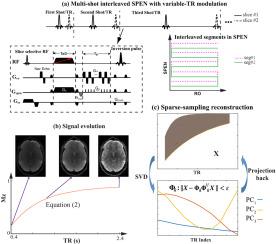Fast T1 mapping MRI in preclinical and clinical settings using subspace-constrained joint-domain reconstructions
引用次数: 0
Abstract
This work aims to develop fast T1 mapping methods for preclinical and clinical scanners based on subspace-constrained reconstructions. Two sequences are explored for rapid T1 characterizations: 1) Interleaved spatiotemporal encoding incorporating variable repetition times. 2) Inversion recovery gradient echo with random sampling of the phase-encoding (PE) dimension. For both sequences, the subspace reconstruction of the signal recovery was applied, to jointly reconstruct the down-sampled images while characterizing the T1 relaxation. In vivo scans on human brains and abdomens confirmed the efficiency of the proposed methods, including compatibility with breath-holding. In addition, Scans on animals with abdominal tumors and dynamic contrast-enhanced T1 mapping on kidneys support the applicability of the proposed methods also in preclinical settings.

在临床前和临床环境中使用亚空间约束联合域重建快速 T1 映像 MRI
这项工作旨在基于子空间约束重建,为临床前和临床扫描仪开发快速 T1 映射方法。该研究探索了两种用于快速 T1 特征描述的序列:1) 结合可变重复时间的交错时空编码。2) 反相恢复梯度回波,对相位编码(PE)维度进行随机抽样。对于这两种序列,都采用了信号恢复的子空间重建,以联合重建下采样图像,同时确定 T1 弛豫的特征。对人脑和腹部的活体扫描证实了所提方法的效率,包括与屏气的兼容性。此外,对腹部肿瘤动物的扫描和对肾脏的动态对比增强 T1 映射也证明了所提方法在临床前环境中的适用性。
本文章由计算机程序翻译,如有差异,请以英文原文为准。
求助全文
约1分钟内获得全文
求助全文
来源期刊

Magnetic Resonance Letters
Analytical Chemistry, Spectroscopy, Radiology and Imaging, Biochemistry, Genetics and Molecular Biology (General)
自引率
0.00%
发文量
0
 求助内容:
求助内容: 应助结果提醒方式:
应助结果提醒方式:


